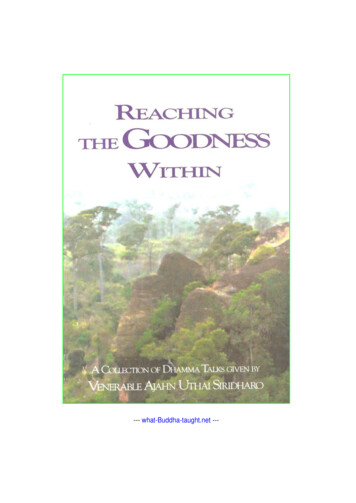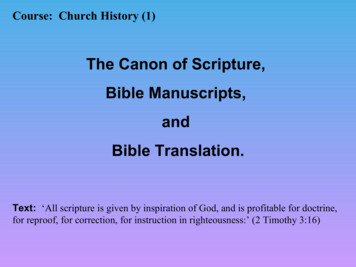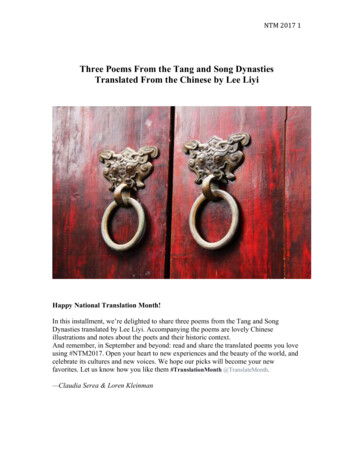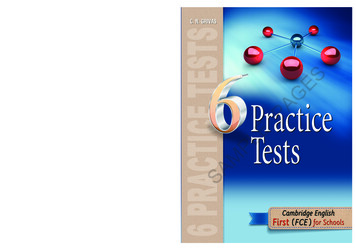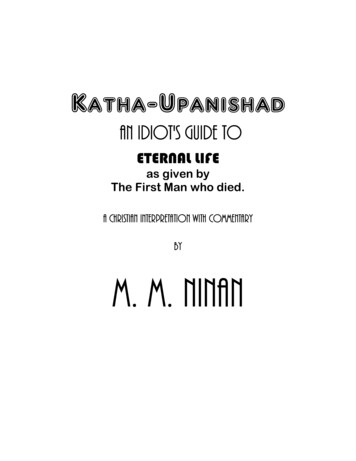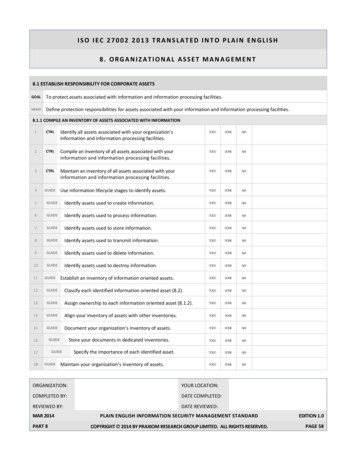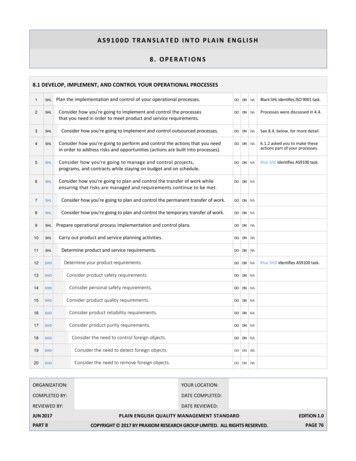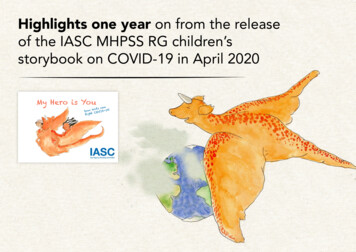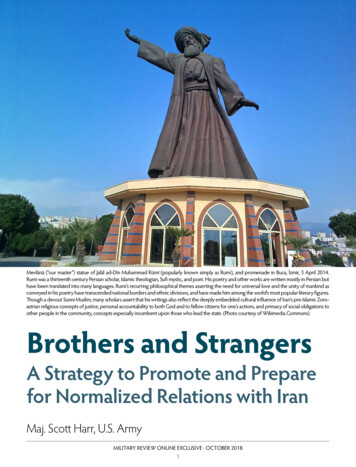
Transcription
Mevlânâ (“our master”) statue of Jalāl ad-Dīn Muhammad Rūmī (popularly known simply as Rumi), and promenade in Buca, İzmir, 3 April 2014.Rumi was a thirteenth century Persian scholar, Islamic theologian, Sufi mystic, and poet. His poetry and other works are written mostly in Persian buthave been translated into many languages. Rumi’s recurring philosophical themes asserting the need for universal love and the unity of mankind asconveyed in his poetry have transcended national borders and ethnic divisions, and have made him among the world’s most popular literary figures.Though a devout Sunni Muslim, many scholars assert that his writings also reflect the deeply embedded cultural influence of Iran’s pre-Islamic Zoroastrian religious concepts of justice, personal accountability to both God and to fellow citizens for one’s actions, and primacy of social obligations toother people in the community, concepts especially incumbent upon those who lead the state. (Photo courtesy of Wikimedia Commons)Brothers and StrangersA Strategy to Promote and Preparefor Normalized Relations with IranMaj. Scott Harr, U.S. ArmyMILITARY REVIEW ONLINE EXCLUSIVE · OCTOBER 20181
RELATIONS WITH IRANIn the thirteenth century, Jalāl ad-Dīn MuhammadRūmī (known today as simply Rumi), one ofPersia’s most influential poets and Islamic scholars, infused his works with a sense of cultural andreligious pluralism that he believed to be an essentialelement of Islamic faith. Indeed, in a famous rubaiyat(quatrain), Rumi declares that in God’s love, “brothersand strangers are one.”1 While the concept of pluralismin the Islamic Republic of Iran today may (unfortunately and erroneously) seem implausible (a productof the rise of Islamic extremism), Rumi had reason tobe optimistic about its prospects. Iran during Rumi’stime, already subdued by Islamic conquest centuriesearlier and yet to be conquered again by the Mongols,seemed destined to be a cultural nexus where Rumi’sIslamic-based values of pluralism would perhapsflourish amidst the comings and goings, and rising andfalling, of various people groups over time. In modernIran however, the pluralism that Rumi passionatelyendorsed has proven quite elusive. Isolated from theinternational community like never before in its history, virtually the entire world appears as strangers toIran. Even internally, pluralism in political and religiousthought remains tenuous at best under a theocraticregime that seems to consider only those hardlinerswho share rigid allegiance to a specific strand of Islamas “brothers” while everyone else remains a “stranger”with little room for coexistence.Despite the current political dynamics in Iran thatare the anathema to Rumi’s idea of pluralism, more andmore Iranians seem willing to protest and advocate forreforms that give them access to greater political andcultural power within their own country. Starting withthe massive Green Movement protesting election fraudin 2009 and continuing early this year with protestsin over eighty Iranian cities, the internal political andcultural landscapes seem ripe for reform.2 Likewise,as scholar Kenneth Walz reminds us, power begs tobe balanced and instability on the global stage (withrespect to Iran-U.S. relations) serves no purpose otherthan to increase the likelihood of irrational decisionsand actions.3 Indeed, a fundamental assumptionundergirding U.S. diplomacy states that U.S. interestsare best served in a stable international environment.4So if significant segments of the Iranian populationseem to desire changes that enhance democratic values,and if U.S. policy aims to create a stable internationalOne SongEvery war and every conflict between human beingshas happened because of some disagreement aboutnames.It is such an unnecessary foolishness,because just beyond the arguingthere is a long table of companionshipset and waiting for us to sit down.What is praised is one, so the praise is one too, manyjugs being poured into a huge basin.All religions, all this singing, one song.The differences are just illusion and vanity.Sunlight looks a little different on this wall than it doeson that wall and a lot different on this other one, but itis still one light.We have borrowed these clothes,these time-and-space personalities,from a light, and when we praise,we are pouring them back in.—Jalāl ad-Dīn Muhammad RūmīTranslator: Coleman s-all-this-singing-one-song/community based on democratic principles, why haverelations between Iran and the United States failed tonormalize? Or, as Rumi himself might ask, why can’t“brothers and strangers be one”?Given the above discussion, the intent of this article isto identify the prominent political and cultural factors inIran today that have resisted democratic reforms. Next,these factors will be discussed and analyzed in terms oftheir implications and impacts on U.S. policy actionsand objectives for Iran. Finally, based on the analysis ofhow current U.S. policy interacts with the predominantpolitical and cultural elements in Iran, a framework for arevised strategy is offered that aims to promote and prepare for normalized relations with Iran while reassertingthe efficacy and sanctity of American values. A strategyMILITARY REVIEW ONLINE EXCLUSIVE · OCTOBER 20182
RELATIONS WITH IRANthat fully accounts for the political and cultural dynamics in Iran and understands their impacts on U.S. actionswhile trusting in the virtues of American principlesstands a better chance of furthering national objectivesaimed at thawing U.S.-Iranian relations.different strategies. The hardliners believe in both adomestic and foreign policy of resistance as the “way” tosafeguard the Islamic Republic from ideological degradation at the hands of Western influence.7 By insulatingthe population from outside interference and relying onpopulist political support and government subsidies foreconomic support (the “means”), hardliners believe theIranian state will ultimately flourish while exposing thecorrupt values of the West.Conversely, the reformists, in trying to achievethe same end, believe that economic engagement (the“way”) with foreign entities will attract the investments(the “means”) needed to economically sustain the coun-National Politics and Culture: theTwin Rally Killers in IranSince the Islamic Revolution that ousted theWestern-supported Shah in 1979 and set U.S.-Iranianrelations on a course for perpetual and increasinghostility, an internal war for the political soul of Iranhas raged that pits the “hardline” supporters of Iran’sPolitical sMeans“Resistance economy,”revolutionary ideologyPopulist dedprivate controlof economyInternationalengagement,open economyEndPreservationand protectionof the IslamicRepublic(Figure by author)Figure 1. Broad Frameworks for National Strategy in IranSupreme Leader, Ayatollah Khamenei, against a morereform-minded cluster of Islamic leaders. As noted byscholar Ray Takeyh, the essential point of contentionbetween the two camps centers on how to maintain astrictly Islamic face on the image and implementationof politics while also (for the reformists) balancing theintroduction of democratic principles that less-strict interpretations of Islam allow.5 Here, a discussion of ends,ways, and means in the derivation of political strategy foreach side is useful. As academic Sanam Vakil points out,the supreme political end for both the hardliners andthe reformists in Iran is the preservation and protectionof the Islamic state.6 However, sharp differences in theways and means to achieve that end account for vastlytry and reduce regional and international tensions thathave, in ways most visible and important to Iraniancitizens, hampered progress (see figure 1).8 To the reformists, economic prosperity is a better (and decidedlymore practical) way to demonstrate Islamic superioritythan the culture of struggle and resistance espousedby the hardliners. Thus far, the results (in terms of realreform) of the political struggle between Iran’s hardliners and reformists have been decidedly one-sided asthe ayatollah, his hardline supporters, and the securityapparatus of his regime—the Iranian RevolutionaryGuard Corps (IRGC)—have been able to ward offperiods of protest from reformers while maintainingalmost total political control of the country.MILITARY REVIEW ONLINE EXCLUSIVE · OCTOBER 20183
RELATIONS WITH IRANControls all elementsElements of national power:Diplomacy:Function ofdiplomacy is toproclaim ideologyof the revolutionInformation:Governmentcontrols mediacensors/blockssocial mediaMilitary:IRGC il of the guardiansGovernmentcontrols keyindustries/policiesControls who can runin (notablyIRGC) controlan estimated80 percentof Iran’seconomy—including keysectors suchas bankingand energy.The most powerful figure in Iran; rules thecountry as the steward of the revolutionaryideology from 1979.Supreme leaderUnelected bodiesElected bodiesApproves/rejectslegislationReform80%Iranian economy“Majlis” (Legislative parliament)Votes20%VotesBecause politicalpower resides in therealm of the unelectedleaders, “bottom up”reform movementscontinually whitherand die when theyreach the unelectedechelons of the Iranianpolitical system.Political powerThe Iranian public/votersIRGCIslamic Revolutionary Guard Corps(Figure by author)Figure 2. Political Power Structure in IranIn maintaining control of Iran, the hardliners enjoyseveral distinct advantages over the reformists. First,all meaningful political power still flows from the“supreme leader” himself as the nation’s most powerful positions remain appointed (rather than elected)billets. While elections have materialized in Iran in thefour decades since the revolution, restrictive mechanisms exist to ensure real political power remains in thehands of the ayatollah and the revolutionary institutions controlled by his Islamic apparatus. For example,all candidates seeking to run for election must be vettedby a judiciary-in-name but regulatory-in-practice bodycalled the Council of the Guardians.9 The ayatollahappoints the members of the council, which in turnensures the preservation of the strict Islamic principlesand ideology of the revolution. To illustrate the reform-stifling effects of the council, during the presidency of Mohammad Khatami (1997–2005), whichhas been viewed as the height of reformist prospectsin Iran since the revolution, the council vetoed almost50 percent of Khatami’s reform-oriented initiativesand supported the incarceration of several of his keyreform-minded staffers.10 And during Iran’s most recent elections, the council culled the list of prospectiveelection candidates to ensure reform-seeking moderates represented just 1 percent of the candidate fieldexhibiting the degree of control hardline leaders maintain over the ideological direction of the state.11In addition to tight control over the nature andscope of so-called democratic processes in Iran, theayatollah has also expanded control of key economicand industrial centers to loyal figures from the securityforces of the revolution. According to analyst RaminJahanbegloo, an influx of senior IRGC leaders havemigrated from their high-level government positionsin the regime to controlling stakes in Iran’s critical economic businesses (see figure 2).12 The convergence ofpolitical power and economic control makes the regimeremarkably durable even in the face of protests. This ispresumably the point of such a system, and the ideological stakeholders are understandably not incentivizedto reform the system that provides for and ensurestheir power and influence.To be sure, just because the Islamist leaders havebeen able to control political and economic powerin Iran since the revolution does not mean that thepolitical currents, trends, and developments withinIran have themselves stagnated. As the emergence ofMILITARY REVIEW ONLINE EXCLUSIVE · OCTOBER 20184
RELATIONS WITH IRANelections suggests, the political constituency in Iran hasundoubtedly evolved and diversified since the revolution as competition for political influence develops.However, the ability of the hardliners to maintainthe concentration of political power in the theocraticleaders ensures that instead of measuring Iran’s political progress in terms of real reform and meaningfulchange, it is instead measured in terms of “momentum”and “prospects for reform”—with only negligible andsymbolic gains thus far.13While the (lack of) distribution of political powermay be the dominant factor preventing the diffusionof democratic values in Iran, elements of Iran’s national culture—especially after almost forty years ofsustained hostility with the United States—also likelyplays a restrictive role in the spread and appeal ofdemocratic principles. The idea of a national culture isitself a slippery subject, especially in a contemporaryenvironment that seems loathe to make generalizations of any kind. Nevertheless, plenty of modernresearch exists to suggest that there are broad aspectsand attributes of culture that distinguish the valuesbetween different people groups. One of the foremostresearchers on this topic is the Dutch social psychologist Geert Hofstede. Introduced in the 1980s, Hofstededeveloped a theory that compared national culturalvalues along six (originally four) different dimensions.According to Hofstede’s research, cross-cultural gapsbetween national entities can be bridged by drawinginferences from the comparison of cultural scoresalong his six dimensions.14While Hofstede’s research is far from universallyaccepted, his cultural dimensions model may providea useful framework to examine elements of Iran’sculture that have perhaps contributed to its reticencein inculcating democratic principles into its societyand politics. For example, one of Hofstede’s culturaldimensions, “uncertainty avoidance,” describes “theextent to which members of a culture or society feelthreatened by unknown situations.”15 According toresearch based on Hofstede’s model, Iran scores highin this dimension which indicates a high degree of“uncertainty avoidance” at the national level. Cultureswith this trait “maintain rigid codes of belief ” and aremore resistant to “unorthodox ideas.”16 While recognizing that Hofstede’s dimensions describe generaltrends/preferences and not individual behavior, Iran’sMohammad Mossedegh was an Iranian nationalist politician, whoserved as Prime Minister from 1951 to 1953. Upon taking office,emulating the example of Turkey, he attempted to cleanse thegovernment of corruption while also introducing many initiativesto modernize the Iranian government and society. These actionscaused significant domestic resentment among entrenched interests. However, when he ran afoul of British economic and nationalinterests as he attempted to nationalize Iranian oil production, hiselected government was overthrown by a coup d’état conducted by royalist elements of the Iranian military, key members ofthe Iranian Shiite clergy, with encouragement and covert supportfrom Great Britain and the United States. The national humiliationresulting from the overthrow of Mossedegh is viewed by many asone root cause of Iran’s bitter resentment toward the United Statestoday. (Photo courtesy of Wikipedia)score on this dimension may help explain the surprising durability of the theocratic regime (as a “rigid”power structure), as Iranians in the post-revolutiongeneration (in general) prefer the known quantity ofan established regime over the uncertainty of tryingto install something new.Similarly, Iran scores low on Hofstede’s “long-termorientation” dimension, which aims to measure theextent to which societies and cultures balance the pastwhen dealing with the future.17 This score suggests a national culture that views societal change with suspicionMILITARY REVIEW ONLINE EXCLUSIVE · OCTOBER 20185
RELATIONS WITH IRANIn this photo by an Iranian citizen journalist and verified by Voice of America (VOA), a crowd of antigovernment protesters marches in the cityof Karaj, adjacent to Tehran, Iran, 2 August 2018. These antigovernment protests by Iranians fed up with their nation’s economic woes spread toat least ten major cities, posing the biggest challenge to Iran’s Islamist rulers since nationwide demonstrations in January 2018. The Iranian rial’sslump to record lows against the dollar in unofficial trading earlier in the month exacerbated popular frustration with economic problems suchas inflation and joblessness. In a sign of Iranians’ frustrations intensifying, some protesters reportedly chanted slogans explicitly calling for an endto the rule of Iran’s Islamist clerics, who took power in a 1979 revolution. (Photo courtesy of VOA)and prefers to maintain established norms. Indeed,portraying the changes associated with Western valuesas ideas that should be viewed with the upmost disdainand suspicion is a common and oft-used narrative fromthe Iranian regime to explain away popular discontentand cast doubt on the viability of Western values.Even if Hofstede’s model is too subjective to strike achord explaining Iranian resistance to democratic principles, forty years of sustained (and in some cases learned)hostility between the West and Iran have almost certainly created aggregate adverse perceptions amongstIranians toward the United States (and vice versa).From the CIA and Kermit Roosevelt’s role in oustinga democratically elected government in 1953, to theUnited States siding with Iraq during Iran’s brutal warwith its neighbor in the 1980s, to George W. Bush’s dubious inclusion of Iran in his “Axis of Evil,” generations ofIranians have grown up with a deep mistrust of the Westin general and the United States in particular.18 Modernstudies aiming to pinpoint Iranian perceptions ofAmericans note that learned hostility often begins in education, where Iranian textbooks tend to paint Americaas the ultimate antagonist against Iran.19 And while polling in Iran is difficult (because of restrictive governmentpractices), some of the most reliable polls conducted inthis century suggest that almost half of Iranians have anunfavorable opinion of the United States.20 It is important to note that “unfavorable” does not necessarily meanunfavorable toward the American people but ratherthe government. Yet while the theocratic system in Iranmay allow for such distinctions between the governmentand population, the democratically elected leaders inthe United States (in theory) reflect the desires of thepopulation and so, on some level, the conflict betweensocieties is perhaps deeper than just political ideologyand policy. In fact, this reality gets at the heart of whyrelations between the United States and Iran have failedto normalize and perhaps suggests ways to craft betterpolicy and, as a centerpiece, military strategy to promoteand prepare for normalization.MILITARY REVIEW ONLINE EXCLUSIVE · OCTOBER 20186
RELATIONS WITH IRANThe Self-Melting Ice-Cream Cone ofAmerican Policy for Iransanctions. Robust sanctions on Iranian military, telecommunications, coal, steel, currency, and other keyeconomic fields and apparatus have contributed toeconomic stagnation in Iran. The implicit assumptionbehind U.S. sanctions is that they will eventually forcethe Iranian regime to choose between impoverishment for its citizens or maintaining foreign policiesthat are hostile to U.S. interests. Yet, given the analysisabove on both the political and cultural dynamics inIran, this key assumption is unviable and virtually ensures that the sanctions have negative and altogetherself-defeating effects for U.S. policy.As demonstrated above and depicted in figure 2 (onpage 4), real political power in Iran remains almost exclusively with the hardliner ideologues from the revolution. Those who control the political power in Iran willnot be coerced by policy (sanctions) from a countrywhose values represent the antithesis of their revolution. Rather, the hardlinMaj. Scott J. Harr,ers can (and do) play onU.S. Army, is a Specialthe cultural misgivingsForces officer serving inIranians have of the West5th Special Forces Groupin explaining the econom(Airborne). He holds aic problems in Iran. TheBS in Arabic languagemost recent protests instudies from the U.S.Iran illustrate the counMilitary Academy andterproductive nature ofan MA in public poliU.S. sanctions. In earlycy–Middle Eastern affairs2018, protests touched offfrom Liberty University,in over eighty Iranian citand he is a recent graduies. While many analystsate of the Command andnoted that causes of theGeneral Staff College, Fortprotests were diverse andLeavenworth, Kansas. Hecertainly the disparatehas served in multiplegroups of protesters didtours in Afghanistan andnot articulate a clear oblocations throughout thejective, two main streamsU.S. Central Commandof dissatisfaction seemedarea of responsibility asto emerge. One wasan infantry platoon leadergeneral frustration overand Special Forces deeconomic conditions thattachment commander. Hehad worsened with themost recently deployedlooming reintroduction ofas an operations officerU.S. sanctions. The other,supporting special operarelated to the first, was ations forces for Operationstark shift in opinion onInherent Resolve.Iran’s foreign policy inDiscussions on effective U.S. strategies relatingto Iran are often dominated by concerns over Iran’snuclear weapons program. Indeed, given the strategicemphasis that U.S. defense and civilian leaders placeon countering the proliferation of weapons of massdestruction (WMD) and considering the destructivepotential of those weapons to alter the geopoliticallandscape in the Middle East and threaten (existentially) the United States, it is easy to understand why, andtherefore, it is worth addressing. However, choosing tonarrowly view strategic options for Iran solely throughthe lens of the nuclear weapons issue, or worse, elevating that issue above the political and cultural aspectsof Iran described above, myopically mischaracterizesthe true issue that needs to be resolved for normalizedrelations. Accordingly, strategies derived from this lineof thinking will likely have significant flaws. Put simply,despite the centrality and criticality of the nuclearweapons issue for Iran, it is not the main problem withrespect to normalizing relations between the UnitedStates and Iran. This fact, perhaps counterintuitive onits surface, is easily discernible when considering thatthe United States enjoys cordial (or better) relationswith the majority of the world’s nuclear powers. So,if normalized relations are largely the norm for theUnited States with respect to nuclear armed states, theweapons themselves are not the issue. The issue is thatIran (i.e., a country with deeply political and culturalhostilities toward the United States) wants to obtainthem. Resolving the political and cultural hostilities between Iran and the United States should be the primary goal of strategies aimed at normalizing relations, andIran’s desires for nuclear weapons should be treated as aproduct (not a cause) of these hostilities.Many of us are familiar with the proverbial“self-licking ice-cream cone,” referring to an individual or organization that only exists to feed itselfwhile contributing no real value to anything outsideitself. With respect to Iran, American policy may becompared to a self-melting ice-cream cone—that is, aself-defeating policy. As noted above, analyses of U.S.policy with Iran often seem subsumed by the nuclear weapons issue. This article will focus on the mainenforcement mechanism used by the United States tocontain Iran and degrade its ability to obtain WMD:MILITARY REVIEW ONLINE EXCLUSIVE · OCTOBER 20187
RELATIONS WITH IRANthe Middle East as protesters railed against a regimethat continues to commit so many resources to fightingArab wars while local Iranians suffer drastic economichardship at home.21 The hardline regime blamed theWest for the protests and the sanctions for the poorhardline regime and lingering cultural scar tissue) topersist. Rather (as articulated in figure 3, page 9), goodpolicy should let American ideals prove their worth onthe international stage and so entice (not coerce) othercountries to emulate American values. good policy should let American ideals prove theirworth on the international stage and so entice (notcoerce) other countries to emulate American values.economic conditions faced by Iranian citizens makingmoderate President Hassan Rouhani a target for blame.In the fray, Rouhani now faces widespread criticism.That the regime can insulate itself from the protestsusing U.S. sanctions reveals an inconvenient truth aboutthe policy: when the regime says that the economicmalaise in Iran is the West’s fault, the use of sanctionsgives that accusation some truth. This creates spacefor the regime to preserve some of its credibility witha population that already culturally prefers the knownquantities of established governments (see Hofstede)and has grown up with plenty of hostile cultural scartissue from the West. The irony (and self-defeating nature) of the U.S. sanctions should not be lost in the mostrecent wave of Iranian protests; the regime has turnedthe bulk of Iranian wrath against a moderate leaderwhose policies have shown a willingness to engage withthe international community. If public backlash againstRouhani leads to his ouster, his replacement will likelynot be someone more moderate or reformist minded.Put simply, U.S. sanctions are contributing to Iranianprotests against a moderate president that, as the regimeportrays the West as the villain to good effect, will likelyswing the country more toward a hardline leader—someone more opposed to U.S. interests.As part of a strategy to promote and prepare fornormalized relations with Iran, the first step the UnitedStates should consider is the removal of all sanctionsagainst Iran to deprive the hardline regime the use ofits favorite card to play during economic crises: “It’s theWest’s fault.” The systemic economic problems in Iranare a symptom of the widespread mismanagement ofits economy by the hardline regime and go well beyondthe effects of U.S. sanctions. As mentioned earlier, Iran’sleaders have centralized control of its key economicinfrastructure in the hands of loyal followers—manyfrom the IRGC and other revolutionary apparatus.This type of cronyism will not allow wealth and prosperity to flourish in Iran and will more likely contributeto huge inequality gaps between those “friends” of therevolution and everyone else.Many who fear the removal of sanctions often relaytwo main concerns with this action. First, they fearremoving the sanctions will rejuvenate the Iranianeconomy with foreign investment and thus give Iranthe solid economic footing to truly control the MiddleEast. However, as noted above, as long as the regimeemploys inefficient economic policies that do not relyon free-market principles, Iran’s problems will likelypersist even with increased investment. There is recentevidence of this dynamic since the signing of the JointComprehensive Plan of Action (JCPOA). Rouhani campaigned on promises of sweeping economic change andrelief with the removal of sanctions after the signing ofthe JCPOA. However, the scope and scale of the expected recovery never materialized, which in part spawnedthe recent protests. Indeed, scholar Farhad Rezaeireports that even with the removal of sanctions, IranianLetting American Ideals Fight forAmerican InterestsAs the chief instrument used in a policy of containment against Iran, sanctions only serve to furtherentrench the political status quo while also creatingnarratives that inflame cultural tensions between Iranand the United States, allowing both (the politicalMILITARY REVIEW ONLINE EXCLUSIVE · OCTOBER 20188
RELATIONS WITH IRANCurrent stateDesired stateStreams ofprotestU.S. militaryefforts exacerbateand expand thisstream throughactions with Arabpartners in U.S.Central CommandStream #1: Foreign ostilityRegimedeflections/blamecreates anti-U.S.sentimentStream #2: EconomichardshipHardlineregimeStream #1: Foreign PolicyHardlineregimeU.S. idealsreinforcestreams ofprotestIranianPublicRegime uses U.S.sanctions todeflect popularprotests along theeconomic streamtoward theUnited StatesStream #2: EconomichardshipRemoval ofsanctions deniesregime ability toblame west foreconomic woesWith no U.S. sanctions to blame for economic mismanagement, the corruption of theregime is exposed. This reality, coupled with U.S. actions to support cooperative Arabpartners, gives both streams of protest more durability-aided by American idealsagainst the regime and, ideally, leads to concrete fissures within the hardline politicalpower structure.The regime can deflect streams of protest to the United Statesbecause of the sanctions that nulls their effects and reinforcesnarratives of hostility between the west and Iran.(Figure by author)Figure 3. Current and Proposed Policy Changes with Desired Effectsbanks remained underdeveloped and ill-prepared to attract the type of foreign direct investment that Rouhanipromised.22 Consequently, economic figures suggest thataverage budgets of Iranian households have fallen 15percent between 2007 and 2017, which notably includesthe period after the signing of the JCPOA.23Sanctions are not at the heart of Iran’s economicproblems, and cronies of the regime getting richer(the likely result of removing sanctions) will do littleto quell the popular protests of everyday Iraniansdemanding economic relief. Removing Americansanctions will not fix the massive problems incurredby the regime’s mismanagement of their economy. Onthe contrary, it will expose them. How much strongerwill the U.S.
Mevlânâ (“our master”) statue of Jalāl ad-Dīn Muhammad Rūmī (popularly known simply as Rumi), and promenade in Buca, İzmir, 3 April 2014. Rumi was a thirteenth century Persian scholar, Islamic theologian, Sufi mystic, and poet. His poetry and other works are written mostly
